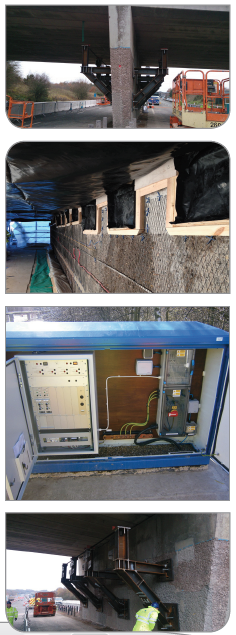 Sprayed Concrete, Hydrodemolition, CP, Freyssibar Installation
Sprayed Concrete, Hydrodemolition, CP, Freyssibar Installation
Client
Highways Agency
Principal Contractor
Amey
Works Commenced
July 2013
Works Completed
March 2014
Ketley and Dawley bridge refurbishment scheme on the M54 Telford was undertaken by Freyssinet between July 2013 and March 2014.
The works consisted of:
- Unsupported phased reinforced concrete repairs to abutments and piers
- Replacement of Ketley East and West central pier bearing shelves and bearings, utilising temporary jacks and support frames.
- Propping the decks from temporary support steelwork supported off the central piers.
- Installation and stressing of Freyssibar in order to retain the steelwork system and transfer the jacking loads into the structure.
- Hydro-demolition of the 16m3 of concrete from each of the 2no central piers. This process was undertaken on 24 hour working in order to maintain the client’s ambitious programme.
- New elastomeric bearings were designed, supplied and installed by Freyssinet in accordance with the clients design requirements.
- Installation of Cathodic Protection (CP) to the structure including the installation of Advitam Transformer Rectifier our in house supplier of these units. The design of the CP system included the installation of a mesh and overlay Impressed Current CP applied to all of the structures installed by Freyssinet’s highly experienced CP team.
- Sprayed concrete overlay applied to all surfaces
Freyssinet was responsible for the access scaffolds for the works. This included the co-ordination of the Record of Design Principles (RDP) process to ensure that the access scaffold was sufficiently designed and checked to avoid impact on the travelling public. Liaison with the traffic management provider to ensure full instigation of procedures.
Freyssinet utilised hydro-demolition for removal of existing concrete. Through liaison with the Environment Agency, we were able to utilise a cost effective method of treatment of hydro-demolition water in order to remove suspended solids and neutralise the water from PH 11 to PH 7-9, before discharge into the highway drainage network.
Welding or reinforcement was undertaken by fully qualified welders who had undertaken weld procedure trials prior to the commencement of the works, in accordance with the chemical analysis/Carbon Equivalent Value of the reinforcement.
Sprayed concrete was used for the repair process. This proved to be less labour intensive than flowable repairs and curing periods for the material used were beneficial to the programme, as the necessary 29n/mm2 were achieved in 2-3 days, allowing the next stage of repair to commence. Freyssinet had previously undertaken extensive sprayed concrete trials in order to demonstrate that our method of working achieved fully compliant repair, fully encapsulating the reinforcement or de-bonding from the substrate.
In addition to the above specialist items we also undertook the following:
- Refurbishment of decks to 3 no. bridges including:
- Treatment and diversion of existing services, in liaison with statutory undertakers.
- Removal of existing carriageway surfacing, kerbing and resurfacing.
- Waterproofing in accordance with Specification for Highway Works.
- Construction of a new slab over the service bays, which was stitched into the existing deck. The process included the treatment and removal of unforeseen asbestos by a specialist contractor.
- Replacement of buried and mechanical deck joints.
